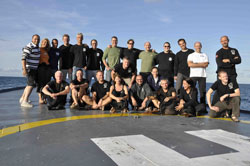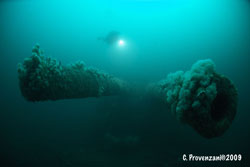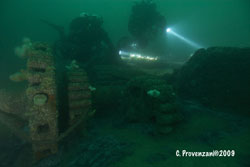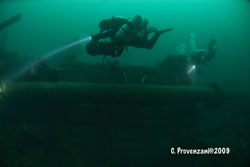GUE Project: Jutland 2009
GUE Project: Jutland 2009
 In August 2009, a new GUE project was undertaken by a diverse team of international participants (Belgium, Germany, Italy, Australia, and Netherlands) with specialized underwater skills in videography and photography. This project took place in northern Europe, 100 miles offshore in the waters of Skagerrak, Denmark, with one goal: to capture the remains of one of the most impressive sea battles in history on film as a GUE DVD before the traces of the past vanished forever. This battle was the Battle of Jutland.
In August 2009, a new GUE project was undertaken by a diverse team of international participants (Belgium, Germany, Italy, Australia, and Netherlands) with specialized underwater skills in videography and photography. This project took place in northern Europe, 100 miles offshore in the waters of Skagerrak, Denmark, with one goal: to capture the remains of one of the most impressive sea battles in history on film as a GUE DVD before the traces of the past vanished forever. This battle was the Battle of Jutland.The Battle of Jutland was the largest naval battle of World War I and the only full-scale clash of battleships in that war. It was the second major fleet action between steel battleships in any war and was also the last.
On May 31 and June 1, 1916, the strong and more-experienced British Grand Fleet of the Royal Navy encountered the smaller and less-experienced German High Seas Fleet of the Kaiserliche Marine.
 The German fleet's intention was to lure out, trap, and destroy a portion of the Grand Fleet, as the German numbers were insufficient to engage the entire British fleet at one time. This formed part of a larger strategy to break the British blockade of the North Sea and to allow German mercantile shipping to operate there. Meanwhile, the Royal Navy pursued a strategy to engage and destroy the High Seas Fleet, or keep the German force bottled up and away from Britain's own shipping lanes. Fourteen British and 11 German ships were sunk, with a great loss of life. In total, there were about 8,500 casualties and 1,000 wounded.
The German fleet's intention was to lure out, trap, and destroy a portion of the Grand Fleet, as the German numbers were insufficient to engage the entire British fleet at one time. This formed part of a larger strategy to break the British blockade of the North Sea and to allow German mercantile shipping to operate there. Meanwhile, the Royal Navy pursued a strategy to engage and destroy the High Seas Fleet, or keep the German force bottled up and away from Britain's own shipping lanes. Fourteen British and 11 German ships were sunk, with a great loss of life. In total, there were about 8,500 casualties and 1,000 wounded.On August 2, 2009, 14 GUE-trained Tech 1 and Tech 2 divers met in the harbor of Antwerp, Belgium, shipped in on the Cdt. Fourcault. Preparation took two years, and still the coordinates and positions of the chosen wrecks were hazy. The following 12 days would tell if the project succeeded or not.
The wrecks are still untouched and even though it has been almost 100 years since they sank, they still show us what chaos must have taken place and what tragedy this battle caused. Just a few divers have ever dived there; little footage of these wrecks is available. It would therefore be the ultimate homage for all the men who died there to capture and share the traces of those events. No one will ever forget what happened and what impact it had.

To accomplish this project, the GUE team consisted of four specialized teams: two teams of photographers and three teams of videographers with High Definition cameras and light assistance. In eight diving days, there were 108 submersions, capturing 24 hours of underwater and topside footage and taking about 1,000 pictures. A selection of the wrecks dived were the SMS Lützow, HMS Queen Mary, HMS Invincible, HMS Defence, HMS Black Prince, and SMS Frauenlob.
These wrecks are considered graveyards and therefore were always treated with respect during the dives, and the video and photo sessions.
 The production of the GUE DVD is in progress and release is to be expected in the coming months.
The production of the GUE DVD is in progress and release is to be expected in the coming months.Team members were as follows: Mario Arena, Christian Batselaer, Peter Brandt, Paolo Carta, Petra Clerx, Marco Cottafava, Andrew Cronan, Chris Dupont, Stephan Matthies, Claudio Provenzani, Derk Remmers, Elena Romano, Aldo Schaap, and Lodovico Venturoli.
Koelakant is a dive-team with great interest in history, archeology and geology that captures with passion and enthusiasm their exploits on video. Team's website www.koelakant.be provides project descriptions, endeavored by the team over time, together with photo and video documentaries.


